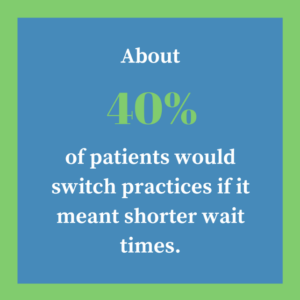Bad reviews are bad for business. They negatively influence your online reputation and can even drive away potential patients.
Wouldn’t it be nice to stop a negative review before it ever gets posted for the world to see on sites like Vitals, Healthgrades or Yelp? Unfortunately, no matter how wonderful your docs are, bad reviews are going to happen.
They’re inevitable…sort of like death and taxes.
Luckily, there are specific things you can do in the office to keep bad reviews to a minimum. Below we’ll share 6 ways you can stop negative reviews in their tracks, mitigate their impact when they do inevitably happen, and even transform them into positives.

1. Don’t Let Patients Play the Waiting Game
The amount of time your patients spend in your lobby forms a critical component of their overall experience at your practice. And online reviews show a distinct trend: wait times matter. According to industry analysts, 40 percent of patients said they would switch practices if it meant shorter wait times.
Moreover, many negative reviews not only discuss the doctors and staff but also focus on how much of their day they had to spend (aka waste) to receive treatment.
When patients are left waiting, they tend to develop negative feelings toward the practice, no matter what the treatment outcome.
To improve your patients’ wait time experience, consider the following:
- Don’t overbook patients
- Compose a list of times for various appointment types and schedule based on appointment duration
- Remind patients of their upcoming appointments a few hours before their scheduled visit
- Offer free internet in your waiting room
- If patients are left waiting for longer than usual, communicate with them and apologize for the delay (70% of patients say a personal apology from their doctor would completely or partially offset their frustration).
Waiting for a perceived length of time can be a pleasant or lonely experience. How you treat patients during the wait makes all the difference. So smile, greet them by name, have fresh magazines, check in with the patient, offer coffee, water, and headphones (because not everybody wants to listen to loud talk TV). Your patients will love the all the more for it.
2. Keep Calm and Be Attentive
It’s important to keep your team composed for the patients’ sake, even if things are hectic behind the scenes (believe us, we know how crazy things can get). From your patients’ point of view, if things look chaotic behind the front desk, they may feel that they’re just another number/obligation/burden (take your pick) for your staff to handle.
To avoid negative reviews, you should make the patient your top priority from the moment they walk in the door until they leave for the parking lot.
Here’s how:
- Dedicate one person to patient engagement at all times
- Communicate with staff members regularly to avoid errors and oversights
- Properly equip your office with the tools to function efficiently (don’t sacrifice patient care to reduce overhead)
- Avoid understaffing
3. Put Your Best Foot Forward
 In your waiting room, as in life, you never get a second chance to make a first impression. Your practice lobby is often the first thing your patients will see. Some may come in stressed out about traffic, or about the visit itself. Having a calm, comfortable, and welcoming waiting area can work wonders for patient (and employee) morale.
In your waiting room, as in life, you never get a second chance to make a first impression. Your practice lobby is often the first thing your patients will see. Some may come in stressed out about traffic, or about the visit itself. Having a calm, comfortable, and welcoming waiting area can work wonders for patient (and employee) morale.
Here are a few things you can try:
- Avoid medical pictures – they aren’t calming or decorative, and are out of place in a modern office environment
- New carpet and furniture can change the feel of your office drastically
- Don’t be afraid to change the colors of your waiting room to give off a positive vibe
- Calming background music (such as classical) will be more effective than that busy AM radio station to help patients relax
- Screens are great in bars, but keep the daily news out of your office (your patients can watch it on their phones if they are jonesing for CNN)
4. The Patient’s Ears Are Always Open
Keep in mind that the patient pays attention to everything, even after they sit down (sometimes even more so once they’re seated). You wouldn’t want them to overhear negative or offensive comments because it may rub them the wrong way. On the contrary, make sure the staff engages in kindhearted small talk, which makes the office seem more cheerful.
Overall, remember to keep the conversations professional and friendly.
5. Ask for, Listen to, and Validate Feedback
![]() At the end of an appointment, if a patient seems aggravated or disappointed, be proactive and invite them to share their experience. Better yet, make it a best practice to ask ALL your patients before leaving your office, how their visit went, whether they display agitation or not. Many people are not comfortable bringing up complaints or suggestions and will keep feedback to themselves if not prompted by your staff.
At the end of an appointment, if a patient seems aggravated or disappointed, be proactive and invite them to share their experience. Better yet, make it a best practice to ask ALL your patients before leaving your office, how their visit went, whether they display agitation or not. Many people are not comfortable bringing up complaints or suggestions and will keep feedback to themselves if not prompted by your staff.
If you don’t reach out to patients, they will find other outlets to express their dissatisfaction. Yep, you guessed it: in the public eye. Here’s what you can do to avoid it:
- Ask about their visit (it shows you care)
- Request feedback about their experience via online and offline surveys or questionnaires
- Thank patients for their feedback, even if it’s negative
- Provide contact information on your social networking sites so they can reach out to you
- Follow up patient input with thank you’s regardless if what they said was positive or negative
- Have a plan in place for responding to both positive and negative feedback
Listening attentively and acknowledging patient feedback will go a long way to diffusing the situation. Almost 75% of consumers who post negative reviews do so to save others from a similar experience.
If a patient shares a criticism (i.e., for having to wait for what they perceive to be a long time), the worst thing you can do is downplay the accusation or try to justify yourself. Here’s an example of a genuinely unhelpful response: “Actually, our wait times are below the average experienced in other practices.”
When your patient senses that you legitimately care about their concern and are taking action to address the situation, that potential negative review on Vitals may just remain a distant thought. Or it may turn into a positive review along the lines of:
“My wait time was a bit long and the waiting chairs uncomfortable, but I was pleasantly surprised when the front desk asked me how my visit went at the end of my appointment. I shared my feedback and was very impressed that the office manager promised me she would look into the situation and get back to me. She agreed that the chairs were a bit outdated. Finally, a practice that really cares!”
6. Get Social
 Did you know that 90% of social media users have used social media to communicate with a brand? Not only that, almost 65% of consumers expect companies to offer customer service on social media.
Did you know that 90% of social media users have used social media to communicate with a brand? Not only that, almost 65% of consumers expect companies to offer customer service on social media.
Social media customer care has arrived big-time on the scene. Over 40% of patients report that social media influenced their choice of a specific doctor, hospital, or medical practice.
The most successful medical practices today interact with new, current, and prospective patients well before they’ve stepped foot in the office. They maintain an engaged, dedicated, compassionate, and professional image to existing and potential patients online – on social media platforms or online reputation management sites. Practices use social customer care to enhance the patient experience, optimize positive feedback, and reduce unfavorable reviews.
Learning how to master the art of social media customer care is critical to keep your patients satisfied, resolve their issues promptly, and strengthen your authenticity.
The Bottom Line
Remember that all the credentials in the world are no guarantee that your patients will recommend your practice to their friends and peers. The overall experience you provide them while they are in your office will be the determining factor for repeat business and referrals to their community.
The reality is that today’s consumer-savvy patients have more choices than ever when choosing what doctor they’re going to see. And they are also less forgiving for poor customer service, making customer care a critical part of the treatment package your offer.
The patient experience doesn’t end just because services have been rendered. It continues and is smack in the middle of what we call the Patient Value Journey, where your patients either never come back or get converted into ardent fans who sing your praises from the rooftops.
When you put your patients first in every aspect of your business, you will stay ahead of your competition, maintain high-star reviews, attract new patients through the front door, and achieve the bottom line results you desire.
